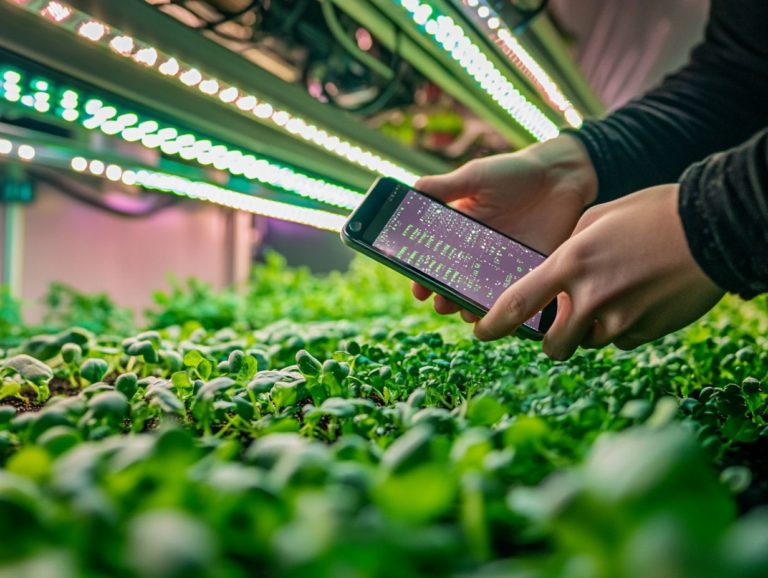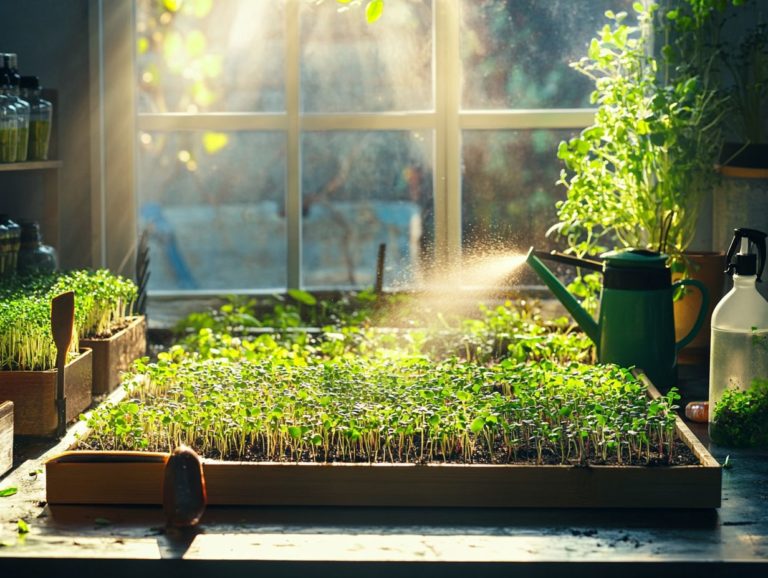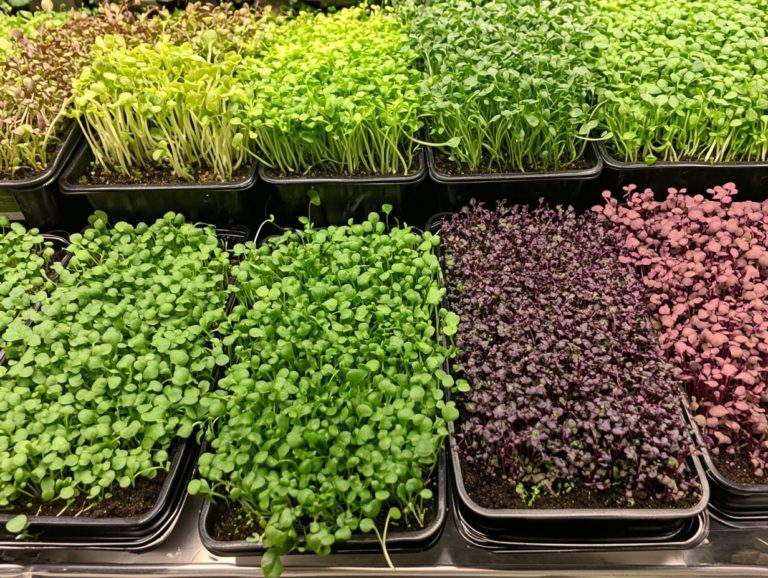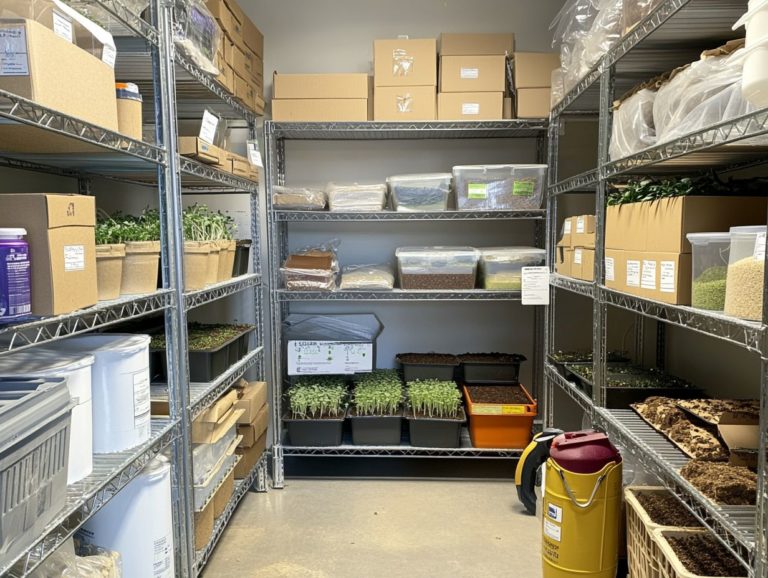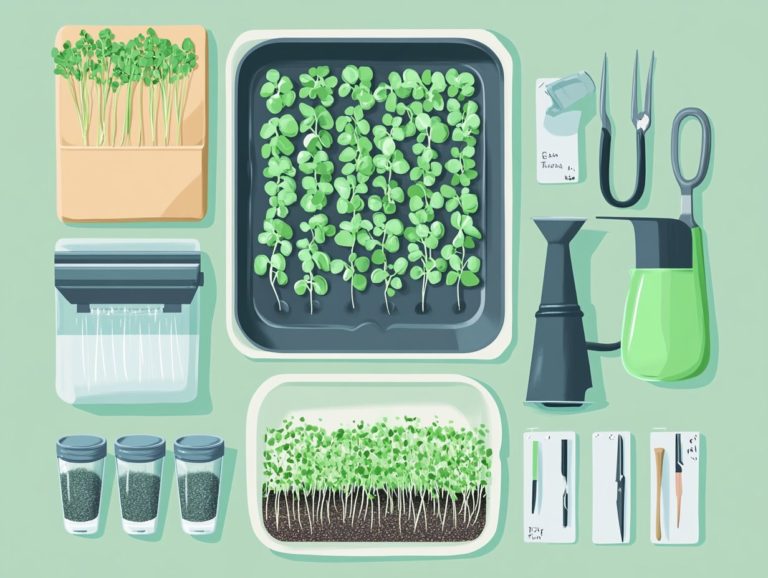5 Best Indoor Microgreen Growing Systems
Are you excited to cultivate fresh, nutritious microgreens right in the comfort of your home?
Whether you re a seasoned gardener or just dipping your toes into the world of plants, grasping the best indoor growing systems can truly elevate your gardening experience.
This article delves into five premier systems hydroponic, vertical garden, soil-based, aquaponic, and aeroponic each offering its own distinct advantages.
It also sheds light on what microgreens are, why they deserve a spot in your garden, and essential tips for setting up and maintaining your indoor oasis.
Get ready to transform your space into a lively green haven today!
Contents
- Key Takeaways:
- 1. Grow with Hydroponics!
- 2. Embrace Vertical Gardening!
- 3. Soil-Based System
- 4. Aquaponic System
- 5. Aeroponic System
- What Are Microgreens and Why Should You Grow Them?
- What Are the Benefits of Using an Indoor Growing System?
- What Factors Should You Consider When Choosing an Indoor Growing System?
- What Are the Different Types of Indoor Growing Systems?
- How Do You Set Up and Maintain an Indoor Microgreen Growing System?
- What Are Some Tips for Growing Healthy and Nutritious Microgreens?
- Frequently Asked Questions
- 1. What are the top 5 indoor microgreen growing systems?
- 2. Which indoor microgreen growing system is best for beginners?
- 3. Can I use any type of seeds for indoor microgreen growing systems?
- 4. Do I need grow lights for indoor microgreen growing systems?
- 5. Are there any benefits of using an aeroponic microgreen growing system?
- 6. Can I grow multiple types of microgreens in one indoor growing system?
Key Takeaways:
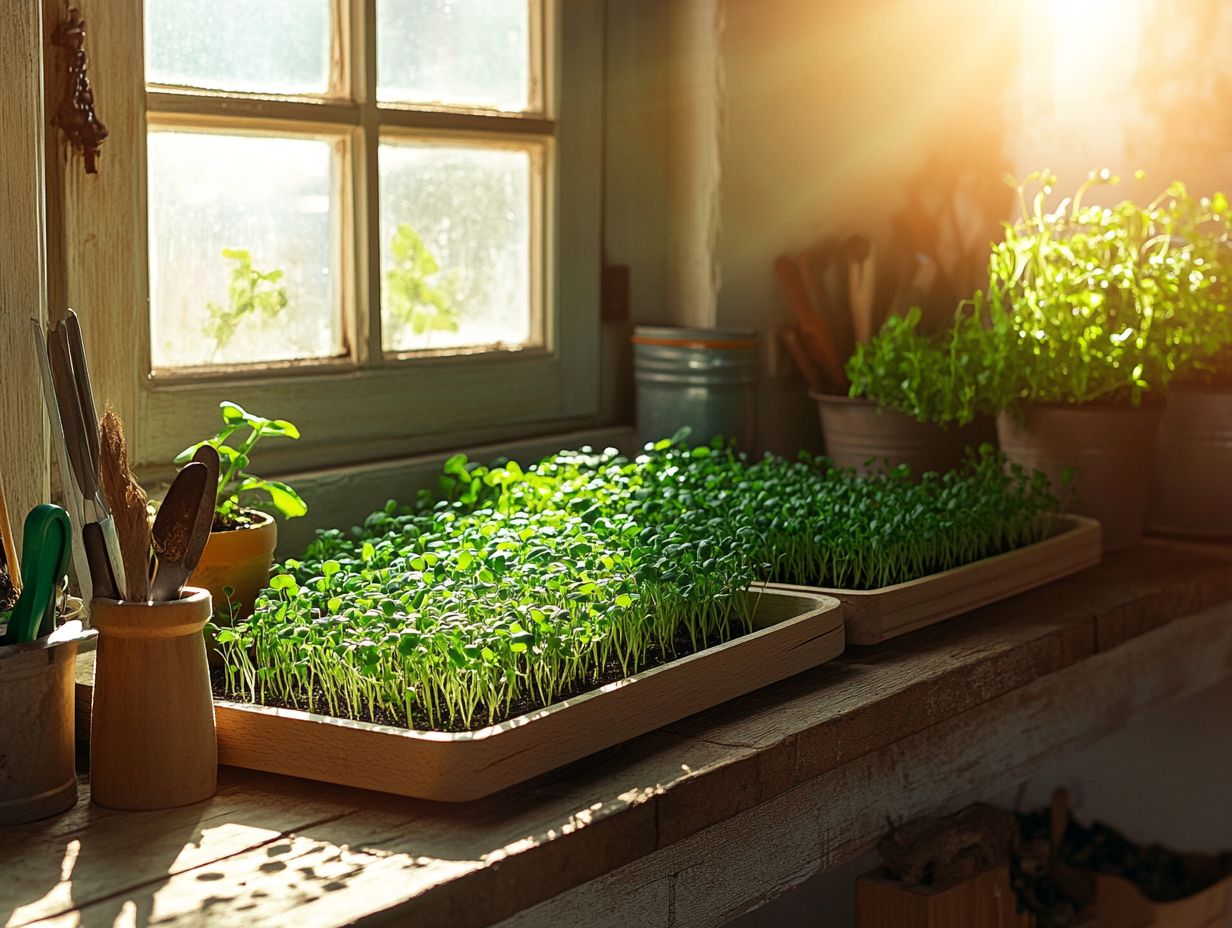
- Discover the top 5 indoor microgreen growing systems: hydroponic, vertical garden, soil-based, aquaponic, and aeroponic.
- Learn the benefits of indoor systems, like year-round harvests and space-saving.
- Consider space, budget, and convenience when choosing your growing system.
1. Grow with Hydroponics!
The hydroponic system is a great way to cultivate a variety of microgreens and plants without the hassle of traditional soil. It effectively utilizes your space and resources, paving the way for a more sustainable lifestyle.
With nutrient-rich water solutions and premium trays, this method enhances your gardening experience and adds a stylish touch to your kitchen countertop, perfect for growing indoor microgreens from responsibly produced organic seeds.
Its compact design offers incredible versatility for those living in apartments or small homes, making it an ideal choice for limited spaces. Unlike conventional gardening methods that demand significant land and constant soil maintenance, the hydroponic approach simplifies care, allowing you to manage everything effortlessly while reducing water usage. For those interested in growing, consider the top 5 microgreens for easy harvesting to maximize your gardening experience.
You’ll find various setups available, from vertical gardens to countertop kits, each tailored to fit your unique lifestyle. Brands like Urban Leaf make it even more convenient with fast shipping and refill options, ensuring you have everything you need to maintain a thriving indoor oasis. For optimal results, consider following the best practices for indoor microgreens without the inconvenience of frequent trips to the store.
2. Embrace Vertical Gardening!
Vertical garden systems offer you a great way to make the most of limited space while effortlessly cultivating a variety of nutrient-dense microgreens. These systems are eco-friendly and stylish, seamlessly integrating organic seeds and designer kits into your home decor.
By embracing vertical gardening techniques, you can transform your small balconies, patios, or even kitchen walls into lush green retreats. The visual allure of greenery cascading from structured planters enhances the atmosphere of any space while promoting a healthier lifestyle by making home-grown produce easily accessible.
Brands like Urban Leaf provide user-friendly vertical gardening kits that come with everything you need to get started, making it simpler than ever for you to experiment with a variety of microgreen mixes. This innovative gardening method caters to both novice and seasoned gardeners alike, fostering sustainability and enriching your daily life with fresh flavors.
Start your indoor gardening journey now and enjoy fresh microgreens at your fingertips!
3. Soil-Based System
Soil-based systems are a favored option for many gardeners like you. They offer a natural setting to cultivate a diverse array of organic microgreens that flourish in rich, fertile soil. This method not only allows you to incorporate backyard compostable materials but also guarantees a sustainable gardening experience. You ll love enjoying fresh, nutrient-rich produce in no time!
In contrast to hydroponics growing plants in water without soil and vertical systems which often depend on synthetic nutrients and carefully managed spaces soil-based cultivation benefits from the vibrant ecosystem of beneficial organisms that thrive in healthy soil.
Utilizing organic growing mediums, such as compost and peat moss, can significantly enhance nutrient retention and microbial activity. To keep your soil in prime condition, it’s essential to engage in regular practices like crop rotation, cover cropping, and adding organic fertilizers.
When choosing seeds, consider growth rate and flavor to ensure a bountiful yield that will please both your gardening efforts and your taste buds. Start your soil-based garden today for a sustainable experience!
4. Aquaponic System
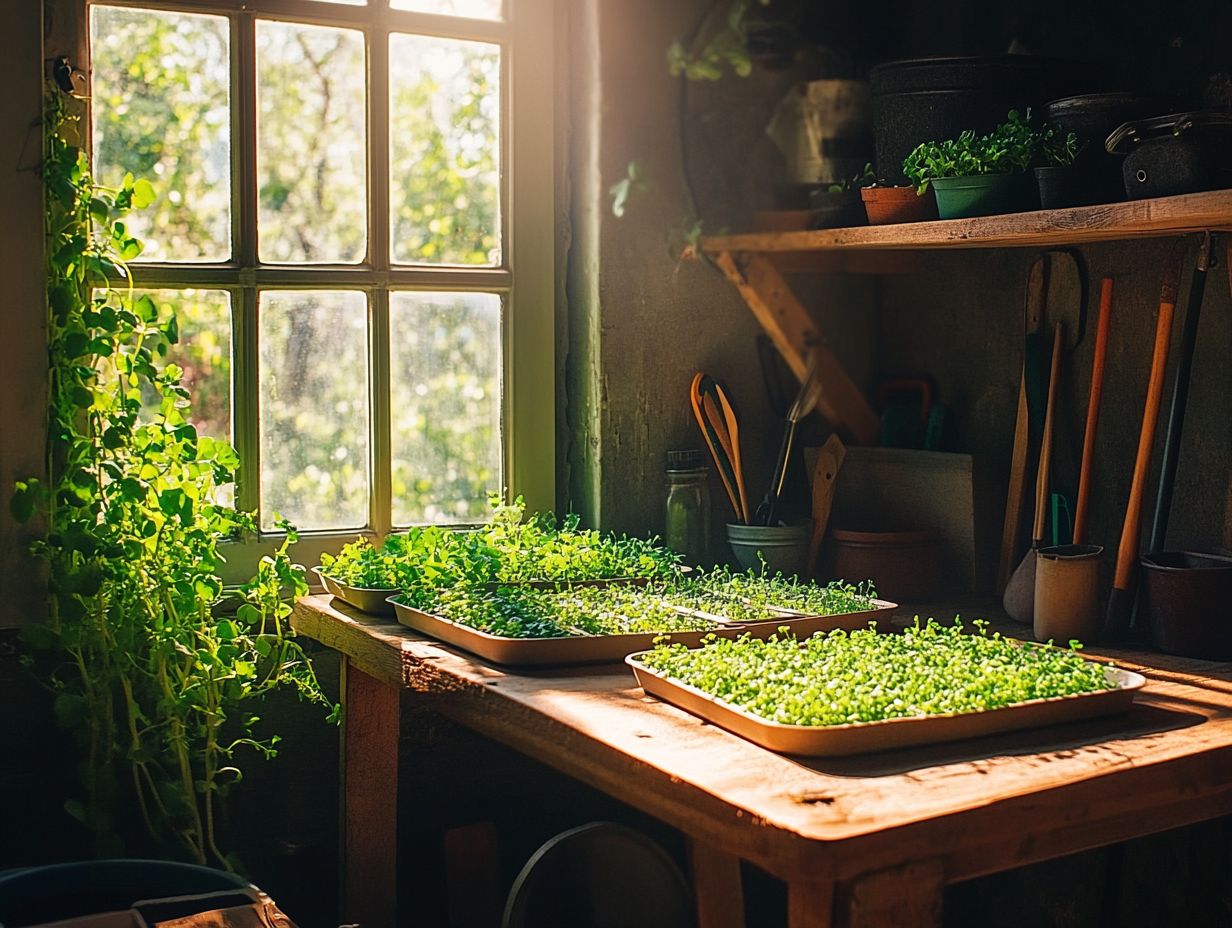
Aquaponic systems offer you a remarkable fusion of aquaculture and hydroponics, crafting a sustainable environment where both plants and fish flourish. Imagine a self-watering system that ensures rapid growth and optimizes resource use perfect for urban gardening enthusiasts like you!
By tapping into the natural cycles of this ecosystem, you benefit from reduced water consumption and minimized waste. The fish waste supplies essential nutrients for the plants, while the plants filter the water, creating a perfect symbiosis.
You might face some challenges, but don’t worry! Overcoming them is part of the fun! You may encounter germination hiccups, fluctuations in water quality, or the delicate balance between fish and plants. By grasping these intricacies, you can cultivate a thriving environment that not only supports biodiversity but also plays a vital role in urban sustainability initiatives.
5. Aeroponic System
The aeroponic system represents a revolutionary approach to cultivating plants in a mist environment, where roots are exposed to nutrient-laden mist. This facilitates rapid growth and yields nutrient-dense microgreens with impressive efficiency. This soil-less technique is user-friendly and particularly advantageous for those who wish to engage in indoor gardening without the limitations imposed by traditional growing mediums.
By leveraging its innovative design, aeroponics maximizes space utilization, making it a prime choice for urban gardeners eager to optimize their limited areas. Unlike hydroponics or soil-based methods, the aeroponic setup requires significantly less water and nutrients, thus boasting a remarkably low environmental footprint.
For those embarking on their aeroponic journey, selecting a suitable system that features a reliable misting mechanism and appropriate lighting is crucial. Routine maintenance entails monitoring nutrient levels and ensuring the mist is consistently delivered, all of which contribute to a thriving gardening experience. Additionally, consider incorporating 5 microgreen varieties you can grow year-round for a diverse and rewarding harvest.
With these factors in mind, anyone can effortlessly achieve exceptional results in their urban gardening pursuits. Don t wait start your aeroponic adventure today!
What Are Microgreens and Why Should You Grow Them?
Microgreens are young, edible greens picked right after their first leaves appear. They re packed with flavor and are full of vitamins, making them a superfood in the kitchen.
You’ll find a delightful array of microgreens, including radish, basil, beet, and sunflower. Each contributes unique flavors and textures to your dishes. Not only do they provide essential vitamins, minerals, and antioxidants, but adding them to your meals elevates both taste and nutrition.
Growing microgreens at home means you have fresh produce right at your fingertips. This promotes a healthier lifestyle while minimizing the carbon footprint often tied to store-bought options. With convenient growing kits, you can simplify the process and enjoy the rewards of gardening without the usual complexities. Discover creative ways to grow microgreens, as this approach creates a meaningful bond with your food, making every meal feel extraordinary!
What Are the Benefits of Using an Indoor Growing System?
Utilizing an indoor growing system presents a wealth of benefits. You can engage in urban gardening in even the smallest spaces, enjoying fresh produce year-round while reducing your environmental footprint.
These systems are designed for ease of use and often come as educational kits. They help you understand the cultivation process and appreciate the journey from seed to harvest. You can effortlessly cultivate a variety of vegetables and herbs, especially when using the best containers for microgreen cultivation, even with limited gardening experience.
This method lessens your reliance on store-bought produce, enabling you to savor freshly picked greens free from pesticides and preservatives. The educational component nurtures a deeper connection with your food as you learn about nutrient cycles and sustainable practices.
By incorporating an indoor growing system into your life, you’re not just embracing a healthier lifestyle. You’re also making fresh ingredients readily available while enhancing your understanding of food sources and gardening techniques. For those interested in growing microgreens, consider these 5 best practices for harvesting microgreens.
What Factors Should You Consider When Choosing an Indoor Growing System?

When choosing an indoor growing system, several factors deserve your attention. Consider budget-friendly options and a compact design if you’re working with limited space. Look for eco-friendly features that support sustainable living while ensuring ease of use for those new to gardening.
It s also important to look at compatible seed types. Different systems cater to specific plants, which can enhance growth and yield. Additionally, ease of maintenance plays a crucial role in how much time you’ll need to care for your plants.
Don t underestimate the value of long-term sustainability. Opting for a system that promotes recycling or reduced energy consumption can truly make a difference. It s wise to assess your unique gardening goals whether you want to grow herbs, vegetables, or ornamental plants to ensure the system you choose aligns perfectly with your aspirations.
What Are the Different Types of Indoor Growing Systems?
Discover various indoor growing systems tailored to different gardening styles. The main options are hydroponic, aeroponic, soil-based, and vertical systems.
Explore each system to find the best match for your space, budget, and skills. Hydroponics grows plants without soil, speeding up growth and boosting yields. Aeroponics involves growing plants in air and misting their roots with nutrient-rich water.
Soil-based systems are perfect for beginners who enjoy a hands-on approach. Vertical systems help you maximize space, making them ideal for urban gardening.
Compare these systems to find the ideal fit for your gardening goals.
How Do You Set Up and Maintain an Indoor Microgreen Growing System?
Setting up your indoor microgreen system is simple with clear steps. This ensures a successful gardening experience.
- First, find a suitable location that offers ample indirect sunlight, or consider investing in grow lights for consistent growth.
- Choose a suitable container, like seed trays or shallow pots, and fill it with high-quality potting soil, ensuring a reliable drainage system.
As you sow your seeds, adhere to the recommended spacing for each type, and lightly mist the soil to maintain optimal moisture levels. For more guidance, refer to the 5 key factors for successful microgreen growing. Keep an eye on signs of over or under-watering, and adjust your lighting or temperature settings based on what you observe.
Don’t shy away from experimenting with different varieties and setups; exploring microgreen varieties that thrive indoors can yield valuable insights and enrich your indoor gardening journey. Sharing your successes and challenges with fellow enthusiasts will foster a collaborative learning environment.
What Are Some Tips for Growing Healthy and Nutritious Microgreens?
Growing healthy and nutritious microgreens requires attention to detail and specific strategies. By selecting quality seed types and using premium products, you can cultivate the finest microgreens.
Providing optimal lighting is essential; aim for 12 to 16 hours of bright, indirect sunlight or use a full-spectrum grow light for vigorous growth. Consistent watering is equally important; develop a schedule that keeps the soil moist but never soggy, striking the perfect balance to prevent mold while nurturing a robust root system. Additionally, consider creative ways to store microgreens at home to maintain their freshness.
Maintain temperatures between 65 F and 75 F for ideal growth. Being discerning about seed quality can dramatically impact results. Don t overlook environmental factors such as humidity and air circulation to cultivate vibrant, thriving microgreens.
Frequently Asked Questions
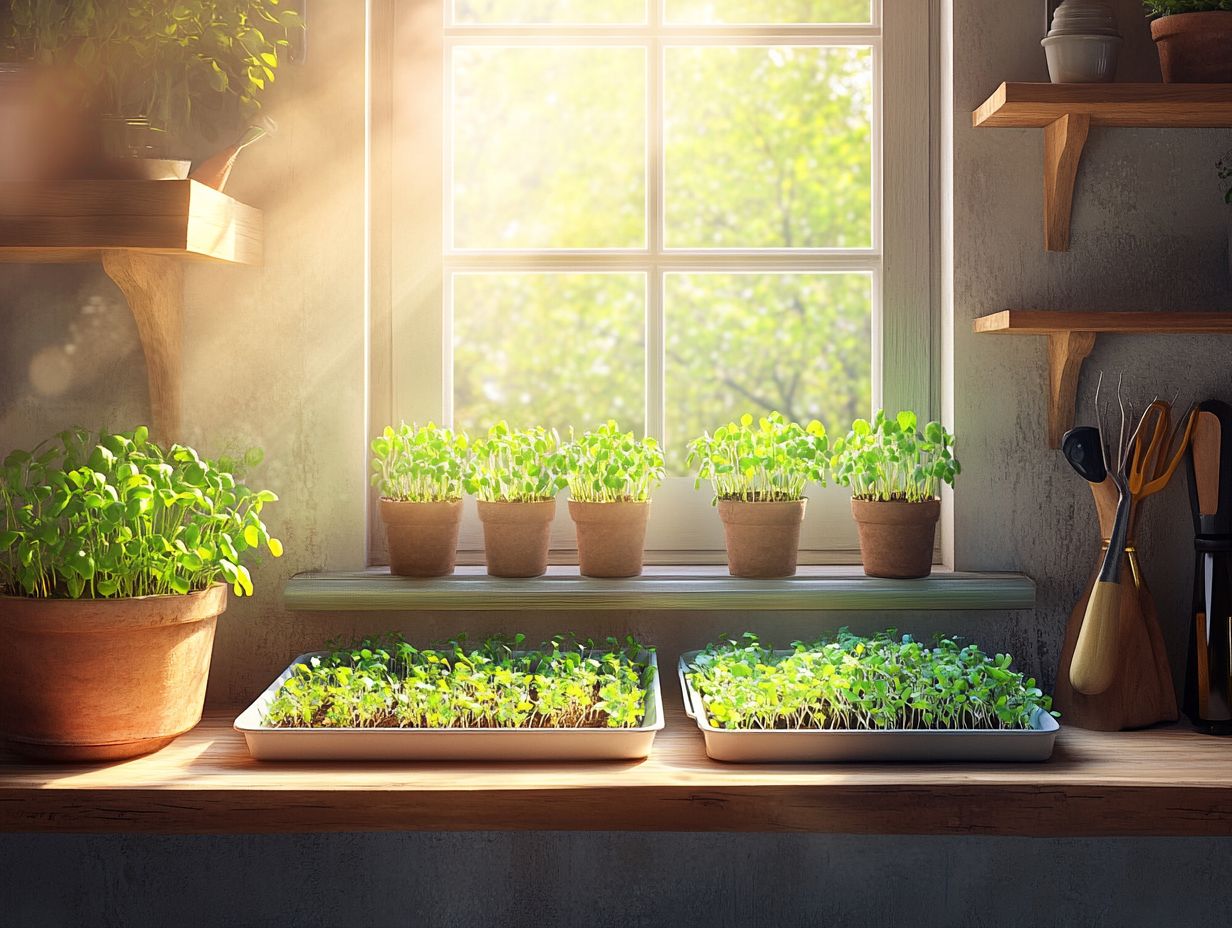
1. What are the top 5 indoor microgreen growing systems?
The top 5 indoor microgreen growing systems include hydroponic systems, soil-based systems, aeroponic systems, vertical farming systems, and self-watering systems.
2. Which indoor microgreen growing system is best for beginners?
For beginners, a soil-based system is easy to set up and requires little maintenance.
3. Can I use any type of seeds for indoor microgreen growing systems?
Yes, most indoor microgreen growing systems can be used with any type of seeds. However, it is recommended to use seeds specifically labeled for microgreens for best results.
Start your indoor gardening journey today and share your microgreen successes with us!
4. Do I need grow lights for indoor microgreen growing systems?
Your indoor space’s natural light will determine your need for grow lights. While microgreens thrive with some sunlight, grow lights can effectively boost their growth.
5. Are there any benefits of using an aeroponic microgreen growing system?
Aeroponic systems use less water and fewer nutrients. They also promote faster growth without soil, making them a cleaner and more efficient option!
6. Can I grow multiple types of microgreens in one indoor growing system?
Absolutely! Some systems allow multiple trays, letting you grow different microgreen varieties together. Just remember to check their growth and harvest times for the best results.

